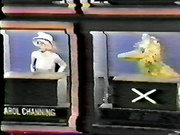Big Bird
|
|
- For other uses, see Big Bird (disambiguation).Missing image
70sesame.jpgBig Bird on a US postage stamp
Tv_sesame_street_dvd_follow_that_bird.jpg

Since Sesame Street began, the world's most famous 8 foot 2 inch big yellow canary, Big Bird, has entertained millions of pre-school children and their parents with his wide-eyed wondering at the world.
Originally performed by Caroll Spinney, this big yellow bird can roller skate, ice skate, dance, sing, write poetry, draw and even ride a unicycle -- pretty talented for a character described in the TV show's writer's guide as a 6-year-old. But despite this wide array of talents, he is prone to frequent misunderstandings, on one occasion even singing the alphabet as one big long word, pondering what it could ever mean (see ABCDEFGHIJKLMNOPQRSTUVWXYZ).
This character helps children feel okay about not knowing everything by not knowing everything himself, and encourages them to enquire: a common phrase in recent years has been: "Asking is a good way of finding things out!". He also teaches other life, alphabet and numerical lessons: "I guess it's better to be who you are. Turns out people like you best that way, anyway."
For many years, his best friend, Mr. Snuffleupagus ("Snuffy" for short), was deemed by the human cast as imaginary. Every time Snuffy would visit, he would coincidentally leave, right before the adults came around. Despite not being believed by the adults, Big Bird continued to assert that Snuffy was real. In the early 1980s, a string of high-profile child sexual abuse cases caused Sesame Workshop (then The Children's Television Workshop) to eliminate this running gag, fearing that children would take away the message that since adults wouldn't believe something out of the ordinary, they'd be just as well off to remain silent.
Big Bird took center stage on Sesame Street in the early 1980s, when the show dealt with the death of storekeeper Mr. Hooper (necessitated by the death of Will Lee, the actor who played the role). Big Bird's realization that Mr. Hooper wasn't just gone temporarily, and Big Bird's acceptance of Mr. Hooper's death, have been hailed as a milestone in children's programming.
As Muppeteer Carroll Spinney has aged, the show has gradually started to train new performers to play Big Bird. These apprentices include both Rick Lyon in the opening theme song of the show's 33rd season, and Matt Vogel in the show's regular new Journey to Ernie segment.
The Big Bird performer is completely enclosed within the costume, and extends his right hand over his head to operate the head and neck of the puppet. The muppeteer's left hand serves as the Bird's left hand, while the right hand is stuffed and hangs loosely from a fishing line that runs through a loop under the neck and attaches to the wrist of the left hand. (For some of the Journey to Ernie segments, a second puppeteer controls Big Bird's right hand.)
Big Bird starred in the PBS pledge drive special Big Bird's Birthday Celebration, in which he turned six. Previous to this, Big Bird was referred to on the show as being four years old. The exception to this is the feature film Sesame Street presents Follow That Bird, in which the Bird is six.
Big Bird starred on the big screen, in the feature film Sesame Street presents Follow That Bird, in which he is kidnapped and dyed baby blue by two ratty circus-owners.
Big Bird also had a role in the feature film Elmo in Grouchland and several other movie-length features such as Big Bird in China and Big Bird in Japan.
While Big Bird is generally deemed as a canary, when he visited The Land of Make Believe on Mister Rogers' Neighborhood, King Friday asked him if he was related to the cassowary. But Big Bird replied. "I'm more of a condor." One nature sketch compared and contrasted Big Bird with "The Noble Ostrich."
Discussion on Big Bird's family
Big Bird lives alone on Sesame Street, essentially adopted by the general neighborhood. Of all the people in his neighborhood, Susan and Gordon Robinson are most likely legally responsible for the six year old, given their recurring parental role towards Big Bird. His apparent lack of family is of serious question, which has never directly been addressed on the show.
Big Bird has commonly mentioned Granny Bird on the show; he has visited her beach side house in various books.
As this is essentially the only relative mentioned, one could just presume he's estranged, or his parents have died. However, this theory is put to waste in many cases, where he mentioned his relatives.
For example, in the song Tall Enough, Big Bird mentions he has a mother, a father, and a sister. One of the volumes in the Sesame Street Library book series has Big Bird visiting several of his cousins. The most solid reference to his relatives is in episode 1576 (from 1981): Big Bird mentions several relatives, one of which is an Uncle Slim, a cowbird from Montana, seen at the end of the episode.
More on this topic in general is discussed in the Sesame Street family condundrum.
Big Bird refers to himself (in the Mr. Rogers episode) as a "Golden Condor."
Big Bird around the world
While many Sesame Street adaptations use characters similar to Big Bird (such as the green parrot Abelardo on Plaza Sesamo), some even use the exact same character. On Zhima Jie in China, Da Niao lives in a nest at the park. Sesame Workshop refers to him as a cousin of the American character. The producers of Sesame Street however usually demand the bird to be renamed and given another color. For instance, in Dutch he is called Pino and is light blue rather than yellow.es:Gallina Caponata ja:ビッグバード
